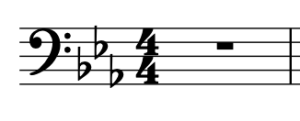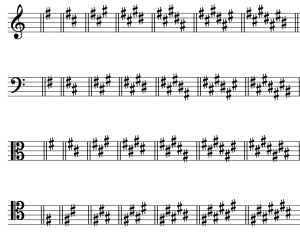I. Fundamentals
12 Major Scales, Scale Degrees, and Key Signatures
Chelsey Hamm and Bryn Hughes
Key Takeaways
- A major scale is an ordered collection of half and whole steps with the ascending succession W‑W‑H‑W‑W‑W‑H.
- Major scales are named for their first note (which is also their last note), including any accidental that applies to the note.
- Scale degrees are solmization syllables notated by Arabic numerals with carets above them. The scale degrees are [latex]\hat1-\hat2-\hat3-\hat4-\hat5-\hat6-\hat7[/latex].
- Solfège solmization syllables are another method of naming notes in a major scale. The syllables are do, re, mi, fa, sol, la, and ti.
- Each note of a major scale is also named with scale-degree names: tonic, supertonic, mediant, subdominant, dominant, submediant, and leading tone.
- A key signature, consisting of either sharps or flats, appears at the beginning of a composition, after a clef but before a time signature.
- The order of sharps in key signatures is F, C, G, D, A, E, B, while the order of flats is the opposite: B, E, A, D, G, C, F. In sharp key signatures, the last sharp is a half step below the tonic (the first note of a scale). In flat key signatures, the second-to-last flat is the tonic.
- The circle of fifths is a convenient visual for remembering major key signatures. All of the major key signatures are placed on a circle in order of number of accidentals.
A scale is an ordered collection of half and whole steps (see Half and Whole Steps and Accidentals to review).
Major Scales
A major scale is an ordered collection of half- (abbreviated H) and whole steps (abbreviated W) in the following ascending succession: W-W-H-W-W-W-H. Listen to Example 1 to hear an ascending major scale. Each whole step is labeled with a square bracket and “W,” and each half step is labeled with an angled bracket and “H.”
https://musescore.com/user/32728834/scores/6815731/embed
Example 1. An ascending major scale.
A major scale always starts and ends on notes of the same letter name, one octave apart, and this starting and ending note determines the name of the scale. Therefore, Example 1 depicts a C major scale because its first and last note is a C.
The name of a scale includes any accidental that applies to the first and last note. Example 2 shows a B♭ (B-flat) major scale—not a B major scale, which would use a different collection of pitches. Note that the pattern of half and whole steps is the same in every major scale, as shown in Example 1 and Example 2.
https://musescore.com/user/32728834/scores/6823280/embed
Example 2. A B-flat major scale.
Scale Degrees, Solfège, and Scale-Degree Names
Musicians name the notes of major scales in several different ways. Scale degrees are solmization syllables notated by Arabic numerals with carets above them. The first note of a scale is [latex]\hat{1}[/latex] and the numbers ascend until the last note of a scale, which is also [latex]\hat{1}[/latex] (although some instructors prefer [latex]\hat{8}[/latex]). Example 3 shows a D major scale with each scale degree labeled with an Arabic numeral and a caret.
https://musescore.com/user/32728834/scores/8452298/embed
Example 3. A D major scale.
Below the scale degrees, Example 3 also shows another method of naming notes in a major scale: solfège solmization syllables. Solfège (a system of solmization syllables) are another method of naming notes in a major scale. The syllables do, re, mi, fa, sol, la, and ti can be applied to the first seven notes of any major scale; these are analogous to the scale degrees [latex]\hat{1}[/latex], [latex]\hat{2}[/latex], [latex]\hat{3}[/latex], [latex]\hat{4}[/latex], [latex]\hat{5}[/latex], [latex]\hat{6}[/latex], and [latex]\hat{7}[/latex]. The last note is do ([latex]\hat{1}[/latex]) because it is a repetition of the first note. Because do ([latex]\hat{1}[/latex]) changes depending on what the first note of a major scale is, this method of solfège is called movable do. This is in contrast to a fixed do solmization system, in which do ([latex]\hat{1}[/latex]) is always the pitch class C.
Each note of a major scale is also named with scale-degree names: tonic, supertonic, mediant, subdominant, dominant, submediant, leading tone, and then tonic again. Example 4 shows how these names align with the scale-degree number and solfège systems described above.
[table “37” not found /]
Example 4. Scale-degree numbers, solfège syllables, and scale-degree names.
Example 5 shows these scale-degree names applied to an A♭ major scale:
https://musescore.com/user/32728834/scores/8452340/embed
Example 5. An A♭ major scale with scale-degree names.
Example 6 shows the notes and scale-degree names of the A♭ major scale in an order that shows how the names of the scale degrees were derived. The curved lines above the staff show the intervallic distance between each scale degree and the tonic.
- The word dominant is inherited from medieval music theory, and refers to the importance of the fifth above the tonic in diatonic music.
- The word mediant means "middle," and refers to the fact that the mediant is in the middle of the tonic and dominant pitches.
- The Latin prefix super means “above,” so the supertonic is a second above the tonic. This is the only "super-" interval.
- The Latin prefix sub means “below”; the subtonic, submediant, and subdominant are the inverted versions (i.e., below the tonic) of the supertonic, mediant, and dominant respectively. (Note that in this text, we prefer the term leading tone instead of "subtonic" when referring to the scale-degree that is a half step below tonic, so named because it is often thought of as “leading” toward the tonic.)

Key Signatures
A key signature, consisting of either sharps or flats, appears at the beginning of a composition, after a clef but before a time signature. You can remember this order because it is alphabetical: clef, key, time. Example 7 shows a key signature in between a bass clef and a time signature.


Key signatures collect the accidentals in a scale and place them at the beginning of a composition so that it is easier to keep track of which notes have accidentals applied to them. In Example 7, there are flats on the lines and spaces that indicate the notes B, E, and A (reading left to right). Therefore, every B, E, and A in a composition with this key signature will be flat, regardless of octave. In Example 8 both of these Bs will be flat because B♭ is in the key signature.
Flat key signatures have a specific order in which flats are added, and the same is true of the sharps in sharp key signatures. These orders apply regardless of clef. Example 9 shows the order of sharps and flats in all four clefs that we have learned:

The order of sharps is always F, C, G, D, A, E, B. This can be remembered with the mnemonic "Fat Cats Go Down Alleys (to) Eat Birds." The sharps form a zig-zag pattern, alternating going down and up. In the treble, bass, and alto clefs, this pattern "breaks" after D♯ and then resumes. In the tenor clef, there is no break, but F♯ and G♯ appear in the lower octave instead of the upper octave.
The order of the flats is the opposite of the order of the sharps: B, E, A, D, G, C, F. This makes the order of flats and sharps palindromes. The order of flats can be remembered with this mnemonic: "Birds Eat And Dive Going Copiously Far." The flats always make a perfect zig-zag pattern, alternating going up and down, regardless of clef, as seen in Example 9.
There are easy ways to remember which key signature belongs to which major scale. In sharp key signatures, the last sharp is a half step below the tonic (the first note of a scale). Example 10 shows three sharp key signatures in different clefs. Here's how to identify each with this method:

- The last sharp (in this case the only sharp), F♯, is a half step below the note G. Therefore, this is the key signature of G major.
- The last sharp, G♯, is a half step below the note A. Therefore, this is the key signature of A major.
- The last sharp, E♯, is a half step below the note F♯. Therefore, this is the key signature of F♯ major.
In flat key signatures, the second-to-last flat is the tonic (the first note of a scale). Example 11 shows three flat key signatures in different clefs. Here's how to identify each with this method:

- The second-to-last flat in this key signature is B♭. Therefore, this is the key signature of B♭ major.
- The second-to-last flat is A♭. Therefore, this is the key signature of A♭ major.
- The second-to-last flat is G♭. Therefore, this is the key signature of G♭ major.

There are two key signatures that have no "tricks" that you will simply have to memorize. These are C major, which has nothing in its key signature (no sharps or flats), and F major, which has one flat: B♭ (Example 12).
Example 13 shows the key signature for C major (no sharps or flats) followed by all of the sharp key signatures in order in all four clefs: G, D, A, E, B, F♯, and C♯ major.

Example 13. The key signatures of C, G, D, A, E, B, F♯, and C♯ in all four clefs.
Example 14 first shows the key signature for C major (no sharps or flats), then all of the flat key signatures in order in all four clefs: F, B♭, E♭, A♭, D♭, G♭, and C♭ major.

Example 14 first shows the key signature of C major (with no sharps or flats), and then the key signatures of F, B♭, E♭, A♭, D♭, G♭, and C♭ in all four clefs.
There is one other "trick" that might make memorization of the key signatures easier: C major is the key signature with no sharps or flats, C♭ major is the key signature with every note flat (7 flats total), and C♯ major is the key signature with every note sharp (7 sharps total).
Major keys are said to be "real" if they correspond to one of the key signatures in Examples 13 or 14. If a double sharp or double flat would be needed for a key signature, then that key signature would be "imaginary." Occasionally, you may encounter music in an imaginary key. Example 15 shows an F♭ major scale; an F♭ major key signature is imaginary because it would need a B𝄫.
https://musescore.com/user/32728834/scores/6817049/embed
Example 15. An F♭ major scale in treble clef.
The Circle of Fifths
The circle of fifths is a convenient visual. In the circle of fifths, all of the major key signatures are placed on a circle in order of number of accidentals. The circle of fifths is so named because each key signature is a fifth away from the ones on either side of it. Example 16 shows the circle of fifths for major key signatures:

If you start at the top of the circle (12 o'clock), the key signature of C major appears, which has no sharps or flats. If you continue clockwise, sharp key signatures appear, each subsequent key signature adding one more sharp. If you continue counter-clockwise from C major, flat key signatures appear, each subsequent key signature adding one more flat. The bottom three key signatures (at 7, 6, and 5 o'clock) in Example 16 are enharmonically equivalent. For example, the B major and C♭ major scales have different key signatures—five sharps and seven flats, respectively—but they sound the same because the notes B and C♭ are enharmonically equivalent.
- Major Scales Tutorial (musictheory.net)
- Major Scales (Practical Chords and Harmonies)
- Major Scales (YouTube)
- Scale Degree Names (musictheoryfundamentals.com)
- Scale Degree Names (musictheory.net)
- Solfège History and Tutorial (Earlham College)
- Scale Degrees, Solfège, and Scale-degree Names (YouTube)
- Major Key Signatures (musictheory.net)
- Sharp Key Signatures (YouTube)
- Flat Key Signatures (YouTube)
- Major Key Signature Flashcards (music-theory-practice.com)
- The Circle of Fifths (YouTube)
- The Circle of Fifths (Classic FM)
- Writing Major Scales (.pdf), from Tonic and Other Scale Degrees (.pdf)
- Writing Major Key Signatures (.pdf)
- Identifying Major Key Signatures (.pdf)
- Major Keys Worksheets for Children (.pdf)
- Scale Degrees or Solfège (.pdf, .pdf)
An ordered collection of half steps and whole steps.
The relative position of a note within a diatonic scale. Indicated with a number, 1–7, that indicates this position relative to the tonic of that scale.
A system that pairs each note of a scale with a particular syllable.
The numerals 0, 1, 2, 3, 4, 5, 6, 7, 8, and 9.
A symbol akin to an angled bracket, placed above Arabic numerals to indicate scale degrees; a circumflex symbol.
The application of solmization syllables (do, re, mi, fa, sol, etc.) to scale degrees.
A movable system of names for scale degrees based on their function within the scale, such as tonic (do, 1̂) and dominant (sol, 5̂).
Raises a note by a half step.
Lowers a note by a half step.
An ordered collection of half steps (H) and whole steps (W) as follows (ascending): W–W–H–W–W–W–H.
An interval of twelve half steps between two notes with the same letter name. The frequencies of two notes related by octave form a 2:1 ratio. Abbreviated “8ve.”
A system of solfège in which do is the first scale degree in a scale; this is in contrast to fixed do, where do is always the pitch class C.
A system of solfège in which do is always the pitch class C, re the pitch class D, etc., regardless of scale.
1. A scale, mode, or collection that follows the pattern of whole and half steps W–W–H–W–W–W–H, or any rotation of that pattern.
2. Belonging to the local key (as opposed to "chromatic").
A 7̂ that is one half step below 1̂. The leading tone is diatonic in major keys, but requires an accidental in minor keys.
Raises a note by two half steps.
Lowers a note by two half steps.
A relationship between notes, intervals, or chords that sound the same but are spelled differently.

